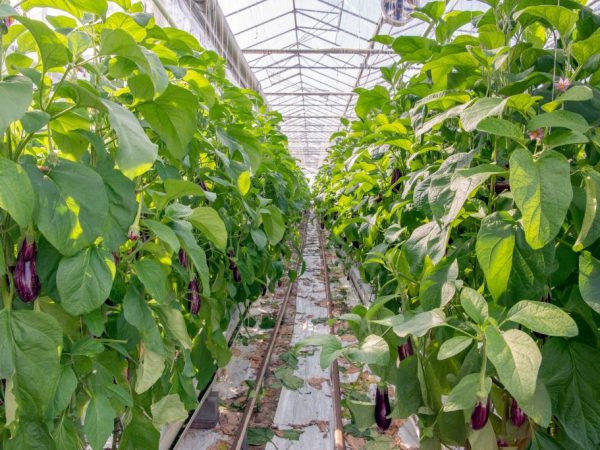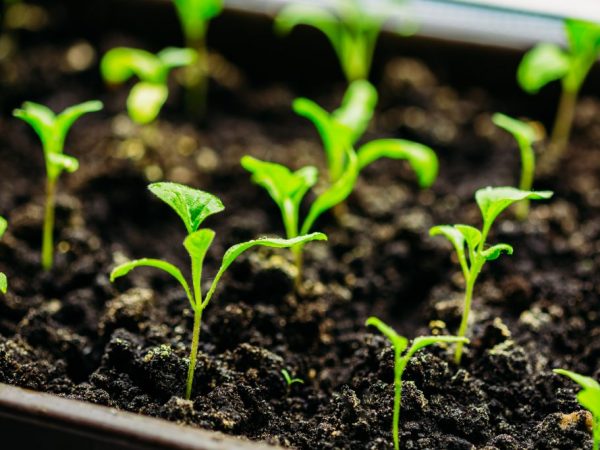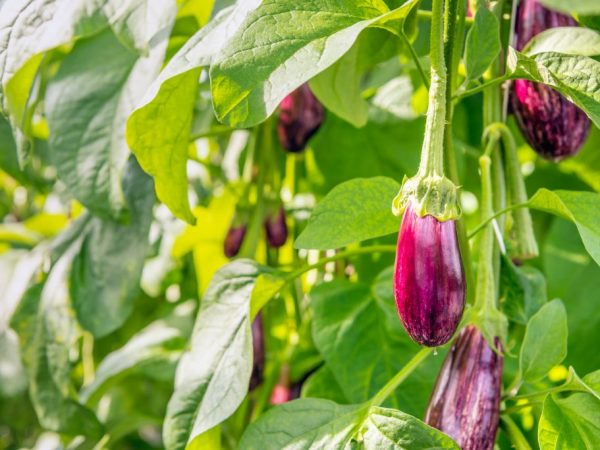How to care for eggplants in a greenhouse
Almost every gardener is engaged in the cultivation of eggplants. Care and cultivation of eggplants in a greenhouse require special attention.

Rules for caring for eggplants in the greenhouse
Choosing a greenhouse variety
Eggplants are planted in any kind of greenhouse. The ideal option is a do-it-yourself polycarbonate or film design.
For planting eggplants, gardeners use undersized varieties and hybrids: in the process of growth, they do not need a garter.
Among the existing varieties, preference is given to the following:
- Bagheera;
- Vikar;
- Moor;
- Iceberg;
- Nutcracker;
- Purple miracle.
Of all the listed varieties of eggplant for a greenhouse, it is better to choose zoned ones.
Seedling preparation
Seeds for seedlings are sown 2.5 months before planting in a greenhouse.
Planting seeds for seedlings is carried out in large seedling containers 8 cm deep and wide. Sometimes peat cubes or halves of plastic bottles are used. In large containers, the sensitive root system of plants is less likely to be damaged, which cannot be said about cramped seedling boxes. After damage, the seedling roots are not always able to recover.
Agricultural technology involves a number of procedures for growing seedlings:
- systemic irrigation;
- fertilization;
- loosening the soil.
From the moment the first leaf appears until the fourth leaf develops, the plants are covered with a darkening material both in the morning and in the evening.
After the air temperature outside stabilizes and reaches 15 ° C, the plantings begin to harden. They are taken out to the balcony, placed in the garden, gradually increasing the duration of their stay in the fresh air.
Moving to the greenhouse
Planting eggplants in a polycarbonate greenhouse is carried out when:
- plants have 8-9 leaves;
- the plants will get stronger and reach 20 cm in height;
- sprouts will have a strong root system;
- flower buds will appear;
- the age of the plant will reach 75 days (in some regions, the planting time is 1-2 weeks less).
Due to the peculiarities of the root system, it is worth transplanting plants into a greenhouse together with an earthen lump.
Sterilizing the soil

The soil for planting must be prepared
To plant a crop under a film, it is worth carrying out autumn preparatory work. The soil is cleaned of the remnants of last year's vegetation, thoroughly loosened and disinfected.
There are different ways to sterilize soil before planting eggplants:
- Thermal (thermal). The soil is treated with steam, boiling water, or ignited in an oven. This method is suitable if a person grows a small number of plants. The heating temperature should not exceed 100 ° C, since at higher temperatures, not only harmful insects die, but also beneficial microorganisms.
- Chemical.Of the chemical preparations for disinfecting the soil, bleach in powder is used: 100 g of the substance is embedded in the ground on a plot of 1 sq. M. Formalin is another effective remedy against diseases and parasites. 200 g of a substance of 40% concentration is dissolved in 10 liters of water. After processing, the soil is covered with a covering material for a day.
- Biological. One of the most efficient and sustainable ways to sterilize soil. The top layer of waste soil - about 20 cm - is removed with a shovel, laid in a thin layer, and then watered with slurry. Such a mixture must be dug up at least once every six months and weed seedlings are removed. The soil, which has high acidity, is additionally limed with fluff: per 1 sq. m of the plot, 4 kg of the substance are introduced.
Nutrient input
Eggplants are grown in a greenhouse, fertilizing only with organic fertilizing. It doesn't matter if it is rotted manure or plant compost, the yield will be good in any case.
On a plot of 1 sq. m make 3-4 kg of compost or rotted manure. Sprinkle the soil with a nutrient, then dig shallowly. Organic matter enriches the soil, improves its structure and reduces acidity.
Sometimes wood ash is additionally introduced separately from organic matter. For 1 sq. m of area consume 250 g of the substance.
To keep the soil loose and light, sawdust is added for eggplants in the greenhouse - 1/2 bucket per 1 sq. m. To retain moisture - 1/2 bucket of peat soil.
It is impossible to plant eggplants in a greenhouse if all of the above conditions are not met. It will not be possible to get strong plants and a good harvest without feeding.
Landing
Planting plants in the ground is the most important step.
Secrets of moving seedlings:
- To facilitate the process of removing plants along with an earthen clod, they are watered abundantly an hour before transplanting.
- The prepared beds are leveled and they begin to dig out the planting holes, the depth of which should not exceed 20 cm.
- Successful cultivation of eggplants involves abundant spilling of the holes with a solution of potassium permanganate - 2 liters in each hole. This disinfects and moisturizes the soil.
- If the seedlings were grown in peat cubes, there is no need to extract the plants.
Landing scheme
It is worth growing eggplants according to a strictly indicated scheme - the distance between the bushes is 30 cm, between the rows - 60 cm. Plants are planted to a depth of 2-3 cm. As a result, 1 sq. m there will be 6-7 plants. Thickened planted vegetables will not develop well and bear fruit.
Care rules
Growing eggplants in a greenhouse should be approached with full responsibility: the seedlings of this vegetable are tender and susceptible to any changes.
After planting, the plants need some time to adapt - about 3 weeks. During this time, the room is no longer ventilated in order to avoid freezing and death of the plantings.

Taking care of plants is not difficult
To care for eggplants in a greenhouse does not require special knowledge and skills. All planting needs is regular watering, good lighting, and warmth.
Forming a bush
The formation of a bush, taking into account the peculiarities of the growth and development of eggplants, is a mandatory procedure. Patching is carried out according to the following scheme: the first pinching of the apical shoot is carried out in plants that have reached 25 cm in height. This manipulation stimulates the growth of lateral stems. Of the total, only 3 pairs of the strongest and most well-developed are left, the rest must be removed.
Such a formation of a bush in the future makes it possible to obtain a strong and compact plant.
Next, the eggplants are looked after by removing non-fruiting stems, yellowed leaves and deformed fruits.
Garter
Plants growing in a film or polycarbonate greenhouse need a garter.
They are tied to a trellis so as not to damage the fragile stems.
The garter is made in several places to provide the plants with stability and prevent the main stem from breaking off.
Watering and moisture
Compliance with the scheme and frequency of watering is the main condition for successful crop cultivation. The first watering is carried out 5 days after planting the seedlings. Water is poured under the root until the soil gets wet to a depth of 20 cm. 12 hours after watering, a loosening procedure is carried out to a depth of 2-3 cm. It will exclude the formation of an earthen crust.
Subsequent soil moistening is carried out as the top layer of the earth dries out. At the same time, the air humidity should not be too high - about 40%. To ensure this, after each moderate watering of eggplants, the soil is mulched with straw, agrofibre or fallen needles, then the greenhouse is ventilated. Watering in combination with mulching prevents the soil from drying out and makes it possible to grow strong plants.
Top dressing
The basic rules for growing eggplants in a greenhouse involve regular and balanced nutrition of the plants.
A vegetable grows well if it is fed with nitrogen in time. Food is carried out in several stages:
- 2 weeks after planting the plants in the greenhouse, a solution of 3 tbsp is added to the soil. l. azofoski and 10 liters of water. For 1 bush, 0.5 liters of fertilizer are consumed.
- The second feeding is carried out after the formation of the ovary. To do this, use 2 options for feeding: mullein infusion (1:10) or mash based on weed and yeast (1: 5).
For those who want to plant eggplants and not think about fertilizing them, there is a simpler option: when planting, 1/3 tsp are poured into each hole. complex fertilizer AVA. After making such a top dressing, every 10 days of planting, they are watered with an infusion of fermented herbs (a bucket of water is required for 1 liter of raw materials).
During pollination and fruiting
To ensure good pollination, the plants are sprayed with Bud or Ovary. It is possible to ensure the mass formation of fruits after pollination, providing plants with foliar nutrition with microelements.
It is impossible to abuse nitrogenous fertilizers. Such preparations stimulate an intensive build-up of green mass, disrupt the natural process of flowering and fruit formation.
Neighborhood with other cultures
It is permissible to plant only some crops in front of the eggplants in the greenhouse. You can grow radishes, onions, dill.
It is permissible to plant eggplants in the same room with cucumbers, tomatoes and bell peppers: the care for them is almost the same. The plant tolerates well the neighborhood with melons: watermelon and melon.
Conclusion
Growing eggplants in a greenhouse is a troublesome and patient process. It is important for plants to create good greenhouse conditions, to ensure regular watering, feeding, and then they will reward with a rich harvest.


